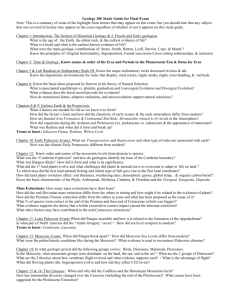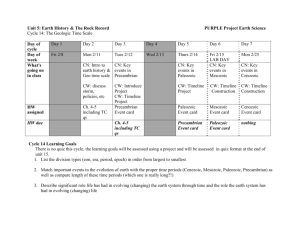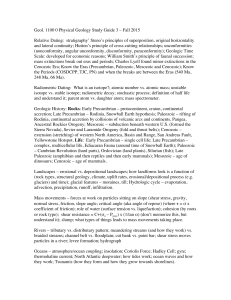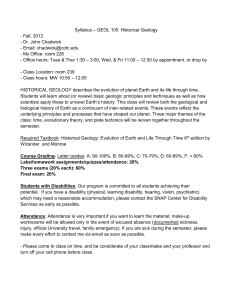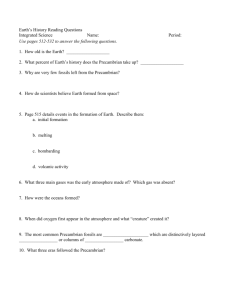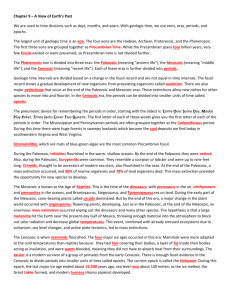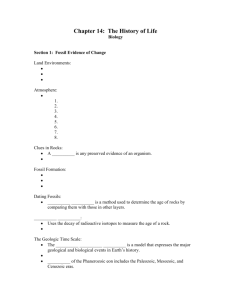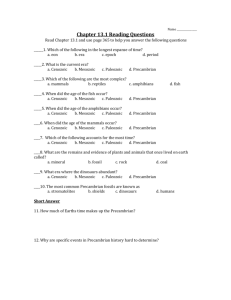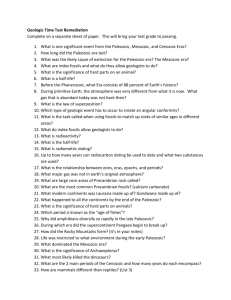Different Types of Volcanoes
advertisement
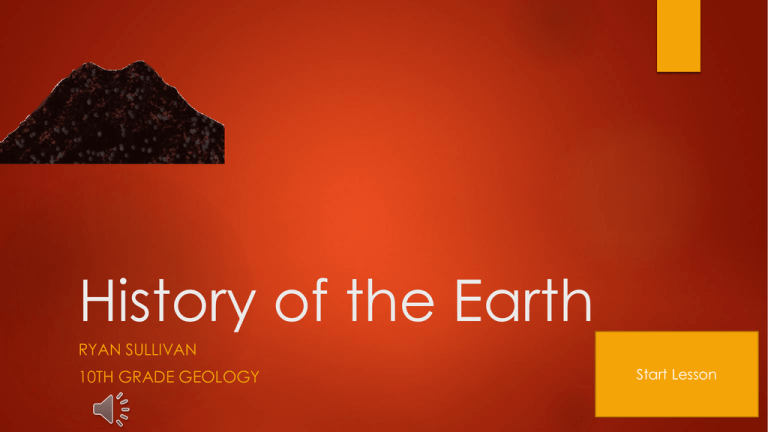
History of the Earth RYAN SULLIVAN 10TH GRADE GEOLOGY Start Lesson Introduction Hello! This interactive PowerPoint is meant to give you an incredibly brief overview of the next unit we will be doing. As you may have already guessed that unit is the history of the Earth. This material will be covered in two main ways, geologically and biologically. This is pretty deep stuff so we will just go over the main features in this unit. Just sit back, relax, and go through this PowerPoint to get an idea of what we will cover over the next few weeks. See you in class! Mr. Sullivan Start Lesson Click On Each Era to Learn More About Them Question Precambrian Geology Paleozoic Geology Mesozoic Geology Cenozoic Geology Precambrian Biology Paleozoic Biology Mesozoic Biology Cenozoic Biology Precambrian Geology Volcanoes erupting everywhere, atmosphere filled with CO2. Atmosphere was much hotter than today. Eventual formation of supercontinent Columbia during early Proterozoic. It later broke up and became Rodina in the Mesoproterozoic. Click Here to Go Back Precambrian Biology Zero life during Hadean eon. Life developed during Archean into simple single celled organisms. (Evidence is Miller-Urey Hypothesis) Eventual formation of eukaryote cells during early Proterozoic. Click Here to Go Back Mesozoic Geology Due to Pangea, many areas far away from the ocean were warm and arid (at least seasonally). There were virtually no glaciers anywhere early on. (Triassic) Heavy rifting in modern North America, reefs formed along continental shelf. (Jurassic) Rifting of Pangea occurred during Jurassic with heavy rifting during the Cretaceous, giving us a more modern appearance of the continents. Click Here to Go Back Mesozoic Biology Slow recovery at start from mass extinction at the end of the Paleozoic. However, there was another extinction at the end of the Triassic True dinosaurs appeared mid Triassic. Plant life evolved to form angiosperms. Large extinction at end of Mesozoic, associated with dinosaur extinction 65 million years ago. Click Here to Go Back Paleozoic Geology Early climate was warm, with periodic glaciation due to Rodina being at the south pole causing a snowball Earth effect. Heavy plate tectonic activity led to breakup of Rodina. Pangea assembled at end of Paelozoic about 252 million years ago. Click Here to Go Back Paleozoic Biology Diversification of life increased rapidly during the Cambrian Explosion, creating almost all of the known phyla today. First land animals appeared in late Silurian. Bony fish flourishing during the Silurian. With land plants also introduced late in Silurian. Massive extinction at the end of the Permian. Over 90% of species died. Click Here to Go Back Cenozoic Geology Appearance of continents becomes what it is known as today. Climate cools and Pleistocene glaciations occur. Messinian salinity crisis occurs. Himalayan orogeny occurs. Click Here to Go Back Cenozoic Biology Humans eventually evolve to what we are today. First whales evolve, as well as fresh water fish. Angiosperms become dominate vegetation. Click Here to Go Back Question time! About form? how long ago did Pangea A – ~252 million years ago B – ~750 million years ago C – ~ 100 million years ago D - ~2 Billion years ago Sorry, Try Again! This is not when Pangea formed. Sorry, Try Again! This is not what the Cambrian Explosion means. Sorry, Try Again! This is not when the Pleistocene Glaciations happened. YAY! Good Job! You are correct! Next Question YAY! Good Job! You are correct! Final Question Thank you for Completing this Presentation! Good Job! Click Here to go back to the Main Menu Question two! The Cambrian explosion means what? A – Cambria began to break apart. B – A long era of volcanic activity. C – The diversity of life increased drastically. D – The diversity of life decreased drastically. Final Question! In what time period did the Pleistocene Glaciations occur? A – Precambrian B – Paleozoic C – Mesozoic D - Cenozoic
